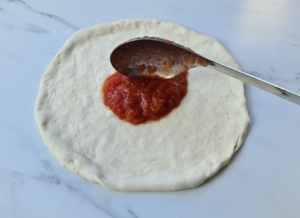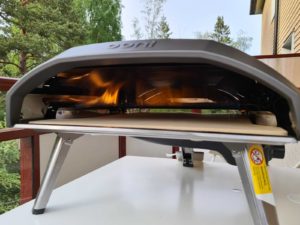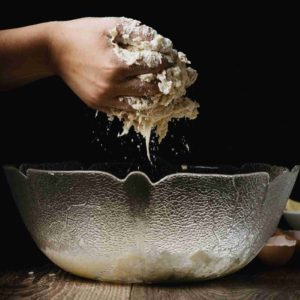Is it possible to make true Neapolitan pizza in a regular home oven? The short answer is no. But that has never stopped me! I’ve tried methods out there and finally landed on the best method to make Neapolitan pizza in a domestic home oven. You can get 99% there using the right tools and techniques. So here’s how to make Neapolitan pizza at home, easier and cheaper – let’s go!
The problem with home ovens
You’ve probably tried baking Neapolitan pizza at home, and wondered why it doesn’t turn out quite right. It’s not like the pizza you tried in Italy, not even like your local pizzeria. Even if you followed an authentic Neapolitan pizza recipe. The crust is dry, dense, and tough, not light and fluffy with a charred, crispy exterior. Like a real Neapolitan pizza should be! But it’s not the recipe, and it’s not you. A regular home oven is simply not the right tool for the job.
The reason it’s hard to bake Neapolitan pizza in a home oven is the lack of heat. The unique characteristics of a true Neapolitan pizza can only be achieved when the pizza is baked in less than 90 seconds. And to be able to bake pizza that fast, you need a hotter oven!
But why is that a problem, you may ask? Neapolitan pizza needs to be baked that hot for two reasons: to puff up and get a soft, nice interior of the crust, and to get the char of the exterior of the crust and bottom. It’s just the only way to achieve the right consistency.
A Neapolitan pizza should be baked at around 900°F (480°C) on an 800°F (430°C) floor. But most home ovens can get anywhere close. 500°F or 550°F at best.
At 500-550°F (250-300°C) it’s going to take 8-12 minutes to bake the pizza. That’s 5-8 times longer than in a wood-fired oven! So naturally, the crust will dry out more. You will get less oven spring and less puff. The temperature is also too low to char the crust properly. A long baking time will also brown the cheese and overcook the toppings.
But there are ways you can get very close to Neapolitan pizza at home, without buying a 10 000 dollar wood-fired oven!
The solution: How to bake Neapolitan pizza in a home oven
To overcome the challenges, you need to increase the temperature of your oven and modify the dough so it turns out closer to a wood-fired baked Neapolitan pizza.
In short, the solution is:
- Using a
pizza steel to crisp the bottom - Use the broiler for extra heat
- Modify the dough to make it bake faster
- Pre-bake the pizza without cheese and toppings
When you bake a pizza in a wood-fired oven the top is baked by the radiating heat from the dome of the oven while the bottom is baked from the heat of the oven floor. It has to be a balance between the two to get an even bake in less than 90 seconds. Both need to be done at the same time without burning.
So to bake the pizza faster, you need to increase both the baking temperature of the top and bottom of your pizza. This requires two things: a hot baking surface and the broiler or grill function of your oven.
But even if we combine these two solutions, you still can’t reach the baking temperatures of a Neapolitan
- Add water to get a softer, puffier crust
- Add oil to help the dough bake faster
- Add sugar to help the crust brown faster
Increase the baking surface temperature with a pizza stone or steel
To bake the bottom of the pizza faster, you need a hot baking surface, like a pizza stones or pizza steels, that you preheat in the oven before baking.
The most important thing when picking a baking surface is how well it transfers heat. A conductive material will transfer heat faster to bake your pizza faster and give more charring. So the closer you want to get to a wood-fired oven, the better heat transfer you want.
Another consideration is how well the baking surface retains heat. Which means how much heat it can hold onto. The more heat it can retain, the more pizzas you can bake right after each other without re-heating the baking surface.
Pizza stone – the budget option
The cheapest way to upgrade your Neapolitan pizza is a pizza stone. A pizza stone retains heat well and dries out moisture from the dough, something that results in a faster, crisper bake.
Pizza stones are most commonly made from ceramic. One of the benefits of ceramic is that it helps dry out the moisture from the crust. But ceramic doesn’t transfer heat as efficiently as for example metal. That’s actually a benefit in a hot
Pizza stones are cheap and can be found at Walmart, Target, or Amazon for as little as 15-25 dollars.
But at the 30-40 dollar price range you can find cordierite pizza stones that are much less prone to cracking, so I highly recommend spending a little more, and getting a pizza stone that will last much longer.
The Unicook Pizza Stone, crafted from durable, odorless Cordierite and capable of withstanding up to 1,450°F, ensures even heat distribution for perfectly crispy crusts. This pizza stone is a must-have for any pizza enthusiast.
Pizza steel – the best baking surface for home ovens
The best baking surface for baking Neapolitan pizza in a home oven is a
A
A
Where to place the pizza steel
To get the most out of your
How to use a pizza steel
Before baking pizza, you need to preheat it for at least 45-60 minutes on the hottest setting of your oven to make sure it’s as hot as you can get it. When the time comes to bake the pizza, simply launch the pizza onto the
I’ve also written an in-depth guide to how to use your pizza steel for the perfect Neapolitan pizza here.
The broiler method
The solution to a faster bake of the top of your pizza is using The broiler method. This will decrease the baking time by several minutes, and you can get beautiful char of the crust.
Most home ovens come with a broiler or grill function. This is typically a heating element located at the very top of your oven. Using the broiler, you can often get beyond the maximum temperature of the oven. When you turn the broiler on, it will give off radiating heat, similar to the heat from the dome of a wood-fired
The heat from the broiler doesn’t reach very far, so you should place your
If the top rack of your oven is much further away than 2 inches, you can place the steel on top of something on top of something to get closer. In my old oven, I used to place my
To get the maximum heat from the broiler, you have to turn it on when you place the pizza in the oven. The reason is that the grill function often turns off on a fully preheated oven. And only comes back on every once in a while, when the temperature drops.
Just a quick warning: you have to keep a close eye on the pizza if you use the broiler method. The pizza can go from done to burnt very quickly!
Modify the dough for baking at lower temperatures
The last thing you should do is to make some changes to the dough to prevent the crust from drying out and give it more similar characteristics to a Neapolitan pizza.
Changing the dough will not make authentic Neapolitan pizza dough, but that’s not the goal. Traditional Neapolitan pizza dough is made in a traditional wood-fired oven. Our goal is to make the end result, the pizza, as close as possible in a home oven. To do this, you can make 3 easy changes to your dough: increase the hydration, add oil, and add sugar.
1. Adding more water to the dough
You can fix many of the issues of the crust by increasing the hydration of the dough by adding more water.
Traditional Neapolitan pizza dough has a fairly low hydration of 55.6-62.5%. Hydration is simply the amount of water in the dough compared to flour (e.g. 1000g of flour and 600g of water give 60% hydration). The reason Neapolitan pizza dough has low hydration is that it’s designed to be baked in a wood-fired oven. And not much water has time to evaporate in the 60-90 seconds it takes to bake the pizza.
For home oven pizza the best hydration is 65-70%.
Increasing the hydration will:
- Make the crust less dry
- Give better oven spring
- Give a softer and airier crust
- Help crisp the crust
And the more water you add to the dough, the stronger these features will be. So I recommend starting at 65% hydration and experimenting from there.
It’s also worth mentioning that increasing the hydration will make the dough wetter and stickier, especially when you go to 70% and beyond. Ant this will make it harder to handle and work with.
You can read more about pizza dough hydration here.
2. Add oil to the dough
Oil conducts heat well and will help the crust bake faster.
Traditional Neapolitan pizza dough is lean, meaning it contains no oil. And the reason is that oil will make the pizza bake so fast that it burns in a wood-fired oven. But when you bake pizza in a home oven, you can use this to your advantage. When you add oil, the pizza crust will bake faster and get crispier. That’s why you find oil in most home pizza recipes, despite the absence in traditional recipes.
A good starting point is 3% oil in the dough. If you add less it will be less conductive and if you add more it will get more conductive. However, if you add too much oil to the dough you will alter the consistency of the crust, and it will get more biscuit or pie-like (just like Chicago Deep Dish pizza).
3. Add sugar to the dough
Adding sugar to the dough will help the crust brown faster.
One of the characteristics of wood-fired Neapolitan pizza is the charred crust. You can achieve charring more easily by adding sugar to the dough. When sugar is exposed to heat it will caramelize and turn brown. So by adding sugar, the crust will brown faster, so you don’t need to overbake the pizza to get a charred crust.
Small quantities of sugar will not affect the flavor of the crust noticeable. A good starting point is 1-2% sugar in the dough.
Pre-bake the pizza to prevent overcooking cheese and toppings
Another problem with baking Neapolitan pizza longer at a lower temperature is overcooking cheese and toppings. Fresh mozzarella melts perfectly in 60 seconds at 900°F (480°C), but at longer bakes at lower temperatures, the cheese doesn’t get the same soft, melty consistency and will brown, or even burn. Other toppings may also dry out or overcook during a longer bake.
An easy way to fix overcooked cheese and toppings is to pre-cook the pizza with only sauce and add cheese and toppings 2 minutes before the pizza is done.
Prepare the pizza with only sauce. Then bake it for 3-6 minutes (depending on the oven temperature), until it’s almost done. Take out the pizza, top it with cheese and toppings of your choice, and place it back in the hot oven for another 2 minutes. This is going to give the cheese a totally different texture, much closer to what you’ll find on proper Neapolitan pizza!
Pizza dough for Neapolitan pizza in home oven
Here’s a simple 24-hour home oven dough that will give you 6 Neapolitan pizzas of 11-12 inches.
The recipe is based on the AVPN International regulations, with some of the changes mentioned in the previous section: higher hydration, adding oil and sugar.
This is a 24-hour room temperature dough. Because time = flavor. Neapolitan pizza needs time to develop both consistency and flavor.
Home oven Neapolitan pizza ingredients
- 922g Tipo 00 flour (100%)
- 600ml cool water (65%)
- 23g of fine sea salt (3%)
- 1g of fresh yeast (0.1%) or 0.28g of active dry yeast (0.03%)
- 28g extra virgin olive oil (3%)
- 18g sugar (2%)
Home oven Neapolitan pizza instructions
- Add water to a mixing bowl and dissolve the salt and sugar.
- Add 10% of the flour while mixing with your hands or a wooden spoon.
- When you have a smooth, batter-like consistency add the yeast and dissolve it (you don’t want the yeast to be in direct contact with salt, as this may damage it).
- Gradually add the rest of the flour while mixing, until you end up with one, single mass.
- Add the oil, and work it into the dough. It’s going to be sticky, but don’t worry, it will work out when you start kneading.
- Move the dough out of the mixing bowl to the countertop, and start kneading. Knead the dough by hand for 15-20 minutes, or in a stand mixer at low speed for 10-15 minutes, until you get a pretty smooth dough. The goal is to develop gluten and incorporate air into the dough.
- Leave the dough covered to rest for 15-30 minutes.
- Fold the dough over itself a few times and form a smooth, round dough.
- Place the dough in an airtight container, or in a bowl covered in plastic wrap, and let it rise for around 14 hours.
- After 14 hours, take out the dough, and cut it into dough balls of 250 grams each. Make sure the dough balls are smooth and even to get round, nice pizzas.
- Place the dough balls in a lightly floured proofing box and let them rise for another 10 hour. If you don’t have a pizza proofing box, you can place the dough balls individual bowls with lid or covered in plastic wrap instead.
You can find more detailed instructions in the Authentic Neapolitan pizza dough recipe. The process is exactly the same besides the hydration and addition of oil and sugar.
How to bake a Neapolitan pizza in a home oven step-by-step
Let’s put it all together and bake some amazing Neapolitan pizza at home!
1. Make the dough
First, you want to start with the dough from the previous section. This is a 24-hour dough, so you should start making the dough the day before you plan to have pizza.
1. Pre-heat the pizza steel
Around 1 hour before pizza time, place the
You can also turn off the broiler during pre-heating to get an even hotter baking surface!
2. Prepare and top the pizza
After 1 hour, take the dough out from the rising box using a dough scraper or spatula and place it in a small pile of flour to make the dough less sticky. Both the higher hydration and the oil will make the dough more sticky than traditional Neapolitan pizza dough.
Next, shake off excess flour and move the dough to a clean part of the countertop. Press the center of the dough flat using your palm and fingertips, but make sure to leave a 1/2 inch (1cm) rim around the pizza base. This is going to puff up in the oven and make a nice, tall crust. Stretch out the pizza to 9-10 inches and add the sauce (here’s a really simple recipe for authentic Neapolitan pizza sauce).
Lightly dust your
3. Pre-bake the pizza
When the pizza is in the oven, turn on the broiler and let it cook for 3-6 minutes. You may have to turn it during baking to get an even bake since most ovens don’t have even heat distribution. But make sure to not touch it for the first couple of minutes. The pizza needs some time to set.
The crust should now puff up, and after 3-6 minutes start to develop a little bit of color. At this time it’s around 2 minutes left of the bake, so pull it out to get it ready for topping.
4. Add cheese and toppings
When the pizza is out of the oven, add fresh mozzarella (fior di latte) cheese or buffalo mozzarella, and the toppings of your choice.
Here are some classic Neapolitan pizza topping combinations:
5. The second bake baking
Place the pizza back in the hot oven. Make sure the broiler is on, and let it bake another 2 minutes until the cheese is nicely melted and the crust browned and slightly charred.
6. Serve
Time to pull out the pizza with tour
Proper Neapolitan pizza at home on a budget
I always dreamed about owning a wood-fired
Back when I bought my first
If you make a purchease through this link, we earn a small commission at no additional cost to you.
You can read my full review of the Ooni Koda 16 here.
Conclusion
By using a
Related
- Is Your Pizza Dough Too Dry? Here is How to fix it! - June 10, 2024
- The Ultimate Guide to the Pizza Dough Windowpane Test - June 8, 2024
- The Ultimate Guide to Autolyse Pizza Dough - June 7, 2024








Hi, how do you measure .28g or dry active yeast? My kitchen scale starts weighing foods at 1g. I’ve looked up conversions and can’t find a straightforward answer. Also, this sounds like very little yeast! I’d love an explanation. Thanks!
The easiest way is to use a more precise scale. I got one that can measure 0.01g just for pizza making.
Another way is to measure 1g and try to divide it in half, then half again. That should be pretty close (of course this is not a very accurate method).
A slightly more complicated, but way more accurate way of measuring small quantities of yeast is to dilute it to a point where it’s measurable. Example: Add 10g yeast + 90g of water to a bowl or container and dissolve the yeast. Now you have 100g yeast-water, with 1g yeast for every 10g of yeast-water. So 0.28g yeast = 2.8g yeast-water.
*28g of dry active yeast.
The recipe calls for (point) .28g active yeast. Is that correct or a misprint! Also is sea salt( 23gms) amt correct in this recipe???
Yes, both are correct 🙂
It’s a slow-rise dough, and so you need small quantities of yeast. The Salt will also help slow down the fermentation in addition to strengthening the gluten.
Dear,
First of all thank you for the amazing articles!
During the pre heating you don’t use the broiler. With the pre bake and second bake you do use the broiler. Do I only use the broiler setting, or do I use a combination, like: fan + broiler?
My settings to choose from on my oven:
1. fan only
2. floor heating
3. top heating
4. floor & top heating
5. floor & top heating + fan
6. top heating + broiler
7. top heating + broiler + fan
Which settings would you recommend? Many thanks!
If you’re baking on a hot pizza stone or pizza steel, I would try 6. “top heating + broiler”.
But every oven is a bit different, so you’ll have to experiment to see which setting gives the best result in your particular oven.